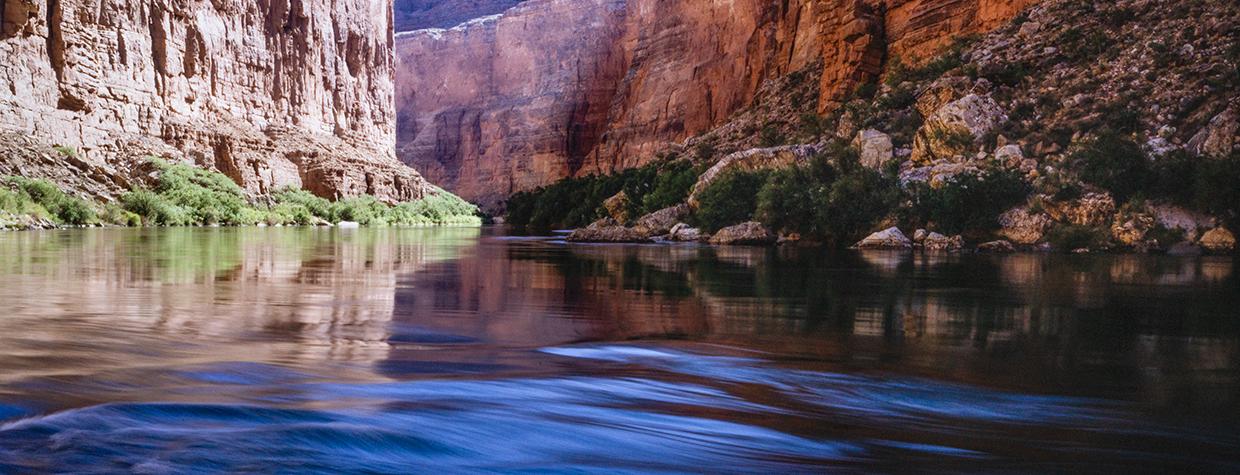Even the Grand Canyon has an edge. Made of limestone and solid to the touch, the edge lies just beyond the aspen groves, past the shaded, damp places where alluringly red and poisonous mushrooms poke through the leaf litter. The edge spans the horizon, leaving no way for someone to walk around it. Beyond it, the Grand Canyon unfolds.
Ravens sail over the threshold, circling above canyons that unravel 5,600 feet below their wings. I imagine that these birds rejoice over their action, that they fly in ecstasy. I am held to the ground while the ravens in front of me trace shapes in the sky at my eye level.
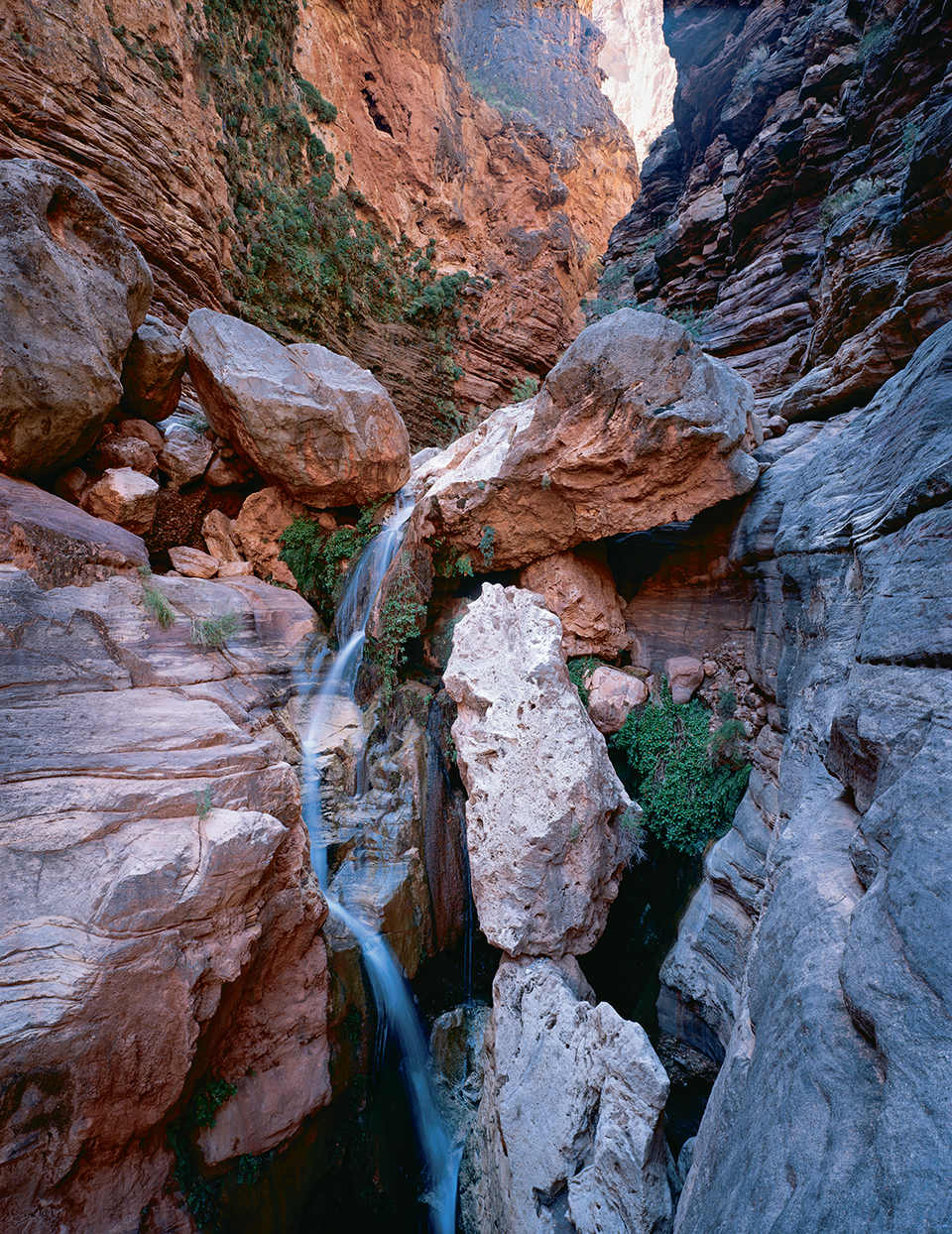
The rim here consists of catwalks, platforms and arches. I walk out on one of these tapered slabs of rock, getting as close as I can to the ravens. The landscape beneath me looks like a shifting skeleton of the planet, rich with many shapes. A first impression might suggest that the shapes are haphazard, a drunken scattering of cliffs and canyons. But another few minutes of watching reveals a system.
Stacks of rock colors repeat themselves at intervals. A cliff, identified by certain contours, flows in and out of canyons, like a person running fingers along a tangled ribbon to find its ends. This kind of land implies that more is hidden down there than a person could uncover in a lifetime.
But you cannot see the Canyon’s finer details and innuendos from this far up. Walk down into it, and you will find rims and terraces and sandstone tables stretching for miles. At the bottom, you will step by seashell fossils on the desert floor, ancient life turned into stone in perfect form. Spend days in one branch of a side canyon — sleeping in its sandstone hollows, drinking floodwater, studying the movements of canyon wrens and the delicately curved spines on a fishhook cactus. Then walk back to the highest rim and look over the handprint of canyons behind you. You will have an inkling of knowledge about the Canyon, a handful of notes. But mostly you will be impressed with a raw sense of magnitude.
I am leaving in a few days to begin four months of travel in the Canyon. At some points, I will be joined by companions. After that trek, I will return for smaller ventures into places missed. This will be done on foot, mostly. I’ll resupply from caches along the way as I follow summer to fall, fall to winter and winter to spring.
The purpose is not to cover the length of the Canyon, to walk each of its major side canyons or to set records. It is to walk the land, focusing on some of its more exquisite, remote details.
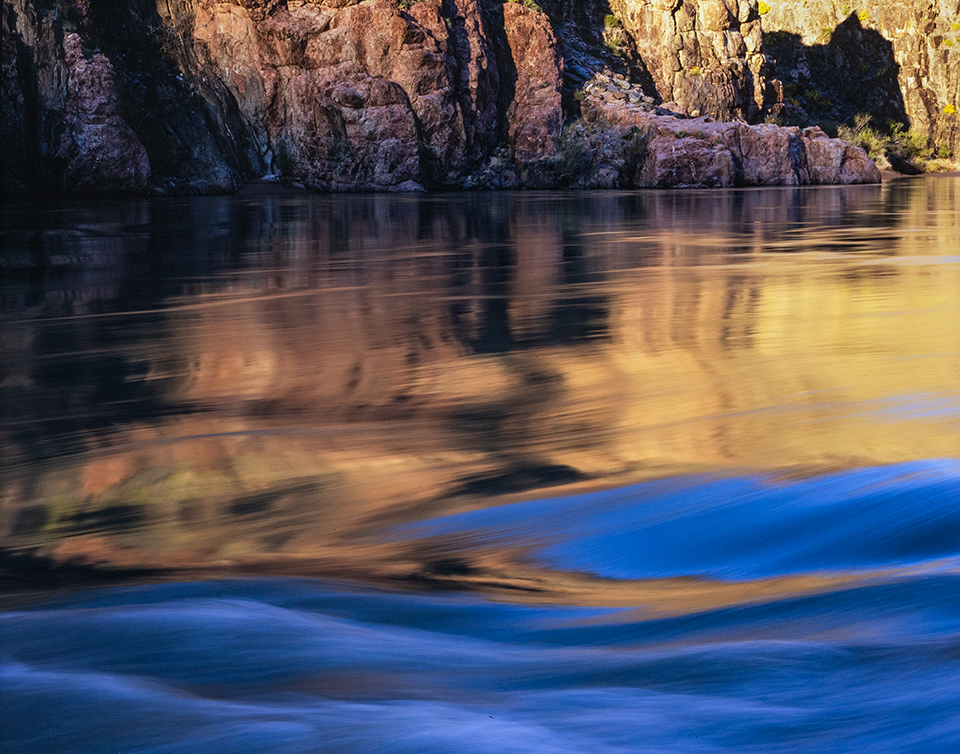
Water, the blade that cut each of these canyons, ranks as the element of consequence here. Water laid these canyons to their depths. It has given the Grand Canyon its unmistakable breadth.
A wave spreads in front of my chest, fanning away and tapping the canyon walls before purling back. I hold my pack over my head to keep it out of the water. I stop and listen. Silence. The canyon swallows the sounds my partner makes downstream. Ahead, the Redwall Limestone curves. It curves again in the opposite direction. Then comes another curve as the canyon slices through solid stone. Its walls are fluted and deeply scalloped by floods.
You don’t come in here by mistake. The inner passageways of these canyons curve too steeply, lie too remote, for you to just stumble across them. Here, you shiver with isolation.
The name Grand Canyon implies that the abyss consists of only one canyon, a giant crack in the landscape of Northern Arizona. Actually, there are more than 600 canyons here, most of them dry, some harboring small perennial streams.
These canyons are tributaries of the Colorado River. Perforating the curve of local plateaus, they fan out like wings from a 277-mile stretch of river, breaking into feathers, then into vanes and tines. Tributaries split in half and split and split again. Counting branch by branch, the canyons eventually number in the thousands. Few of them have names. Fewer have trails. In most, decades will grow between human footprints.
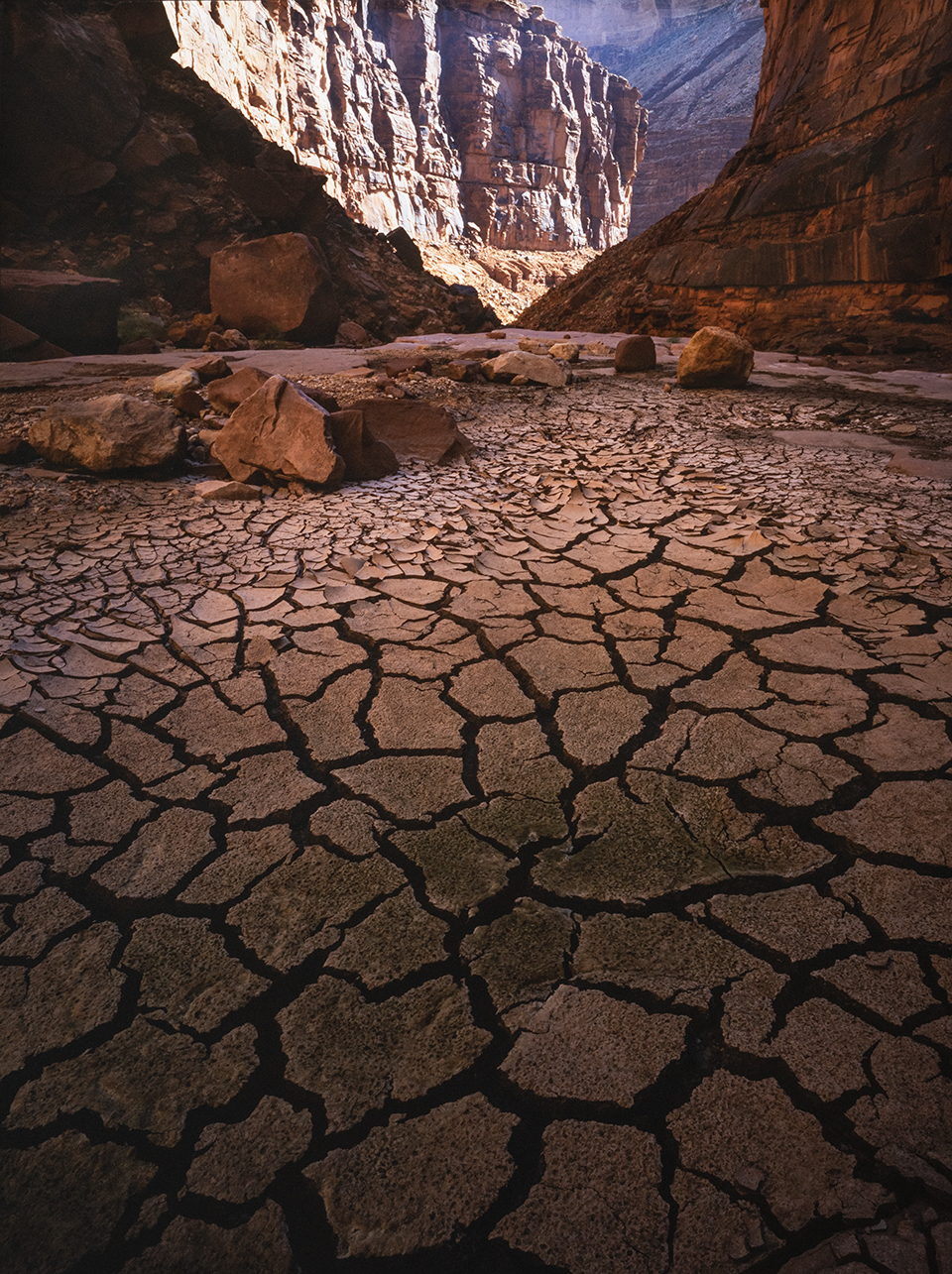
The canyon I’m in now — SB — widens and tightens as if breathing. Overhead, ellipsoidal bulges of limestone block the sky. Several weeks ago, I watched a flash flood cascade from the rims and enter this canyon, sending a dun-colored mist straight up the walls. The floodwater remains. It seeps cold and clear from springs, spilling through consecutive pools. Some places are filled chin-deep, while others are left with only swollen, damp sand at the bottom.
Boulders, some of them a fine-grained sandstone from 4 miles away, are lodged in and above the water, carried here by the flood. Where passing boulders have struck the walls, the limestone has turned a powdery white. Above that, a steel gray defines the canyon, and farther up — 300 feet over my head — the stone has absorbed a red stain from the leaking iron oxide of formations 4,000 feet higher. The deepness of the canyon and the absorptive color of the walls works the afternoon light into a dimness no stronger than a gibbous moon. I tip my head in the half-light and drink from the canyon floor. No need to carry water.
When I come around a turn, finally climbing from the water and seating my pack over my shoulders, I find my partner. He stands straining to see down from the tip of a boulder. He looks back at me. The way he smiles, I know we have come to another dead end. The boulder, 7 feet wide, has wedged into the canyon floor, creating a talkative waterfall below.
We will have to climb. Again.
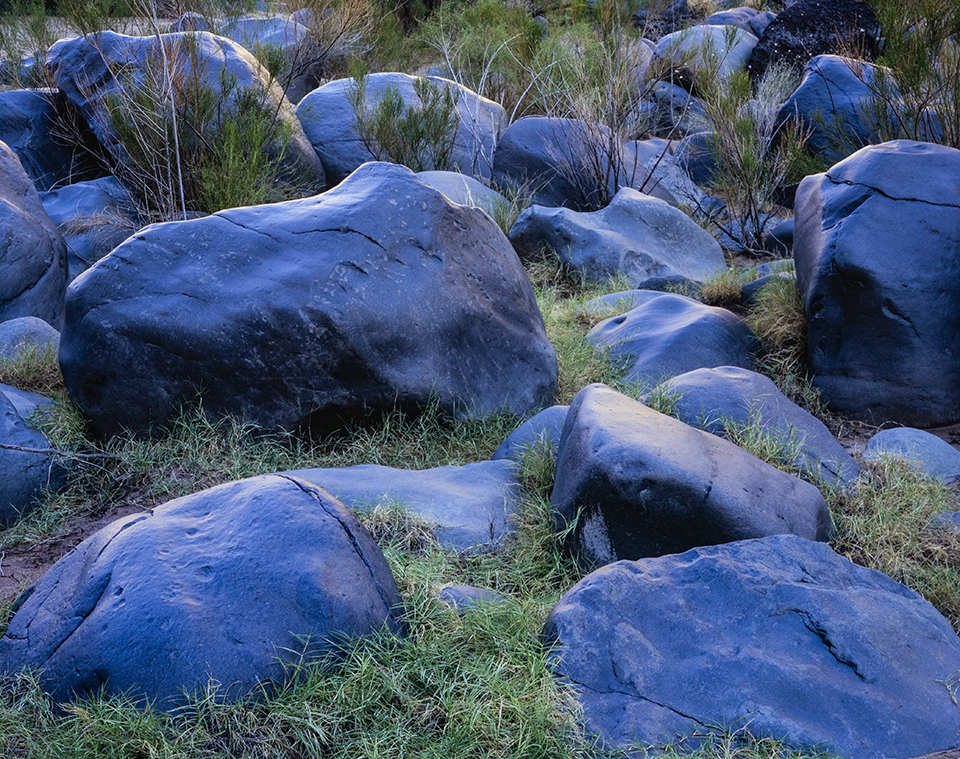
Another time, and alone, I reached the top of SB Canyon, seeking refuge in its inner shadows. Down into the canyon at dawn, my gear left tucked into the rocks for safekeeping, I followed the deep, bucket-like depressions that floods had carved from bedrock. The air, moist before sunrise, smelled strongly of something like freshly cut herbs. Cottonwood and western redbud trees, monkeyflower and seepwillow shrubs. I stopped for a while to listen to a spring. A drop of water fell every 15 or 30 seconds, tapping the surface of a pool I could not see. The sound was so private that when I stood and walked ahead, I did not look back to find it.
Deeper into the canyon, formations arose around me. When a light-blue bed of limestone appeared beneath my feet, the canyon plunged. Now, set within it, a line ran straight into the canyon floor. It was another canyon, dark as a cave even as the sun came up. I climbed in where I could. I swam in the deeper stretch where water had pooled. Maidenhair ferns crowded at small waterfall springs, the kind frequently exposed in the Redwall Limestone. My presence set in motion a clockwork of pools below. Matching exactly the volume of my body, water spun down a chute, topping the next reservoir and spilling over again. The repercussions of my act sent word into the canyon.
I could go only so far. A boulder choked the narrow canyon, and for me, SB stopped.
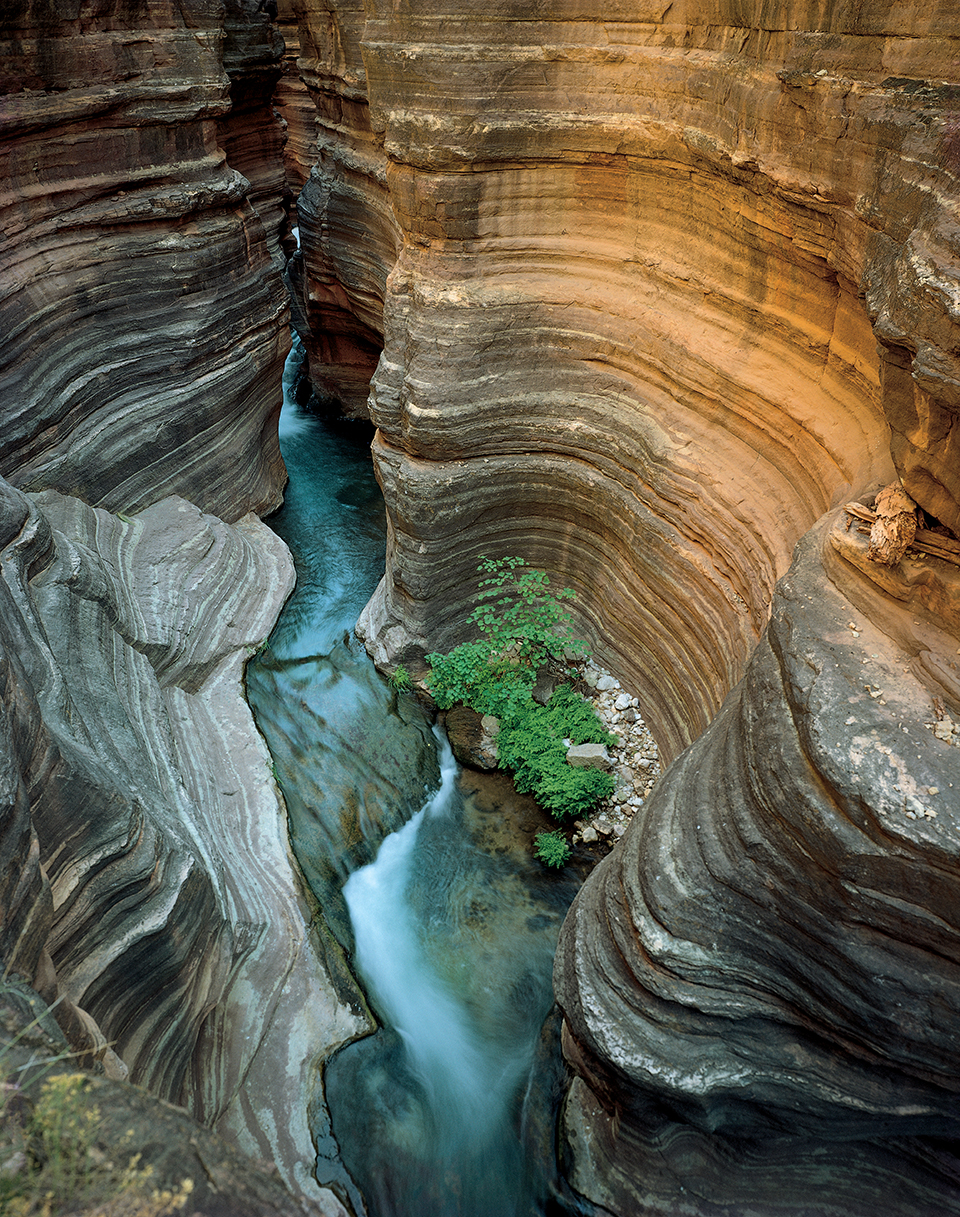
O n another attempt, I lower myself into a pool and wade across to watch my partner, Tom Vimont, work his way down. We intend to reach the Colorado River, then climb back along these same routes. But the river may as well not exist. There is nothing but this canyon. I feel as if I must hold my breath as I walk through. The walls swing from side to side, forming overlapping waves that look more like water than rock. There is no true floor, only a depression of water and gravel or a curve of scoured bedrock.
I come to the next obstacle, another array of rocks jammed between two walls. One of these chockstones lies low on the floor, building waterfalls through its seams. Another is left suspended where a flood once jammed it between walls. This second boulder, 4 feet high, hangs 30 feet off the floor. The arrangement looks as if it were hand-placed by someone with a sense of order and artistry.
Below is a pool. Bottomless, as far as I can see. The curve of the route is difficult, the length of the drop daunting. Tom stands beside me and we look down, hoping to see a handhold or some small crack that can aid in getting us up and down. There is nothing to say. The final piece of webbing is brought out. Loops tied. Anchored and lowered into place. It does not reach the water. We will have to go to the end, then drop. Coming back, we’ll have to swim under it and reach, in hopes of snatching the line. Sounds impossible.
For 10 minutes we look into this water. A 40-ton boulder hangs before our heads. “I’ll be the scapegoat,” Tom finally says. “I don’t think I can do this.” I study his eyes. I don’t think I can do it, either. The canyon has ended.
Still, Tom has ideas about how to get to the end of this canyon. They involve some other time, coming in with a certain amount of rope, pulling it down behind us to use on the boulders ahead, finding a route out from the river, perhaps up Kanab Creek or Tuckup Canyon. Staring into the water, he unravels his plans. He asks me what month would be good and, man, it would have been something to have reached the river, wouldn’t it?
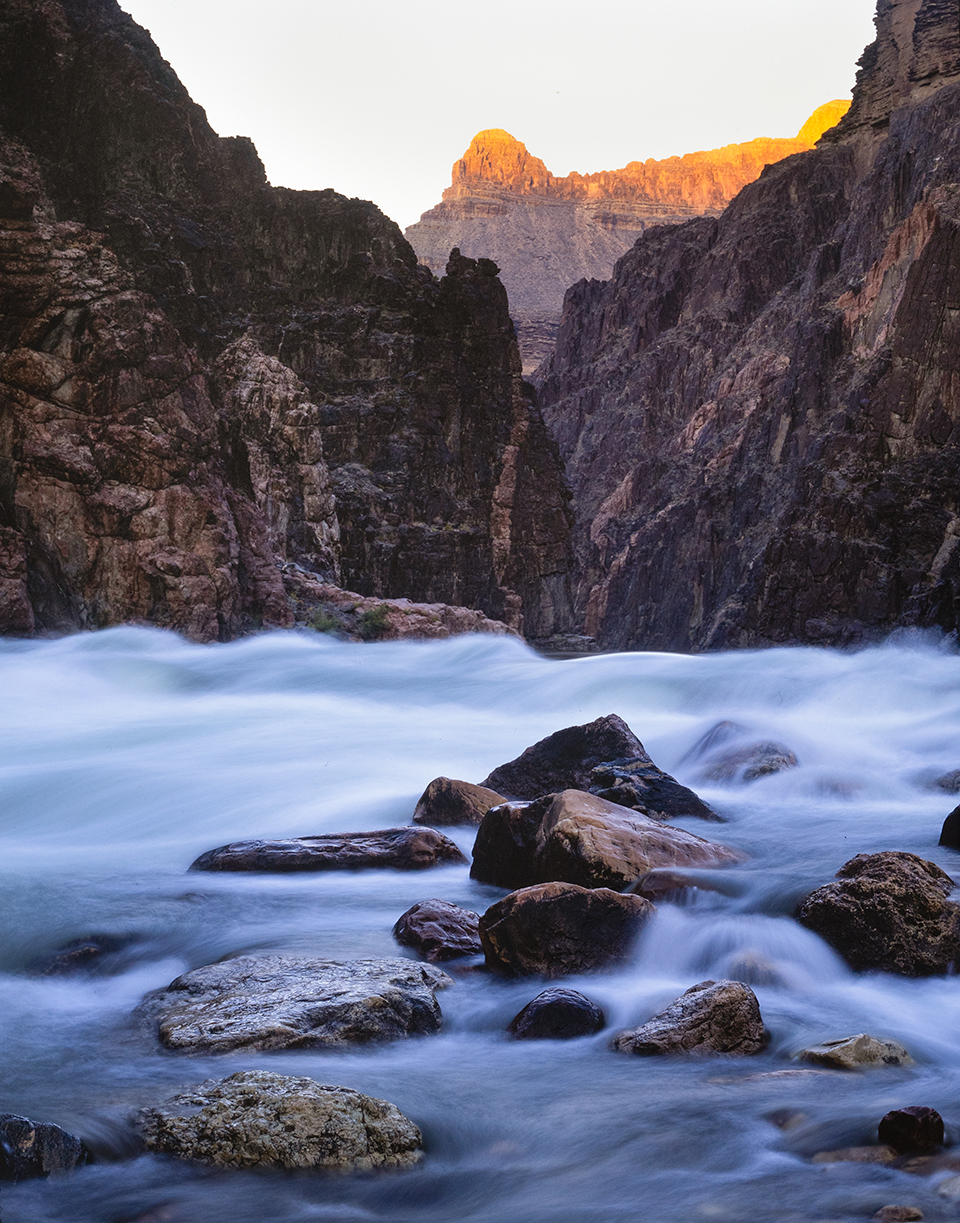
I am looking into the same water. The canyon still is not mine. Never will be mine. The satisfaction of this is rich and inexplicable. With understandable reluctance, Tom reels the webbing back up the rock. It catches a couple of times between boulder and wall, and he snaps it loose. When the last few feet are slithered up, he unclips the carabiner, and the canyon beyond falls from my grasp. It is dusky and curved, drawing water into subterranean shapes just out of view, down where the stream echoes around boulders. The enigma down there is raw. It is a clear and perfect reminder of what is out here, what the land is made of. Secrets are everywhere, and meant to be kept.
At night we set a meager camp on stream cobbles a quarter-mile upstream. We listen to the ornate, etching sounds of water over small rocks. Above us, a series of escape ledges provide space where we can scramble if a flood should come.
But we give little thought to floods tonight. Just thoughts of this canyon. We do not have sleeping bags or pads. Only sand and delicately rounded stones. We each find our place. Tucking hands under my head, I curl into the rocks, like an animal. Stars gather in the narrow cleft of sky, and I swear that if I reach up, they will spill, powdering my face.

